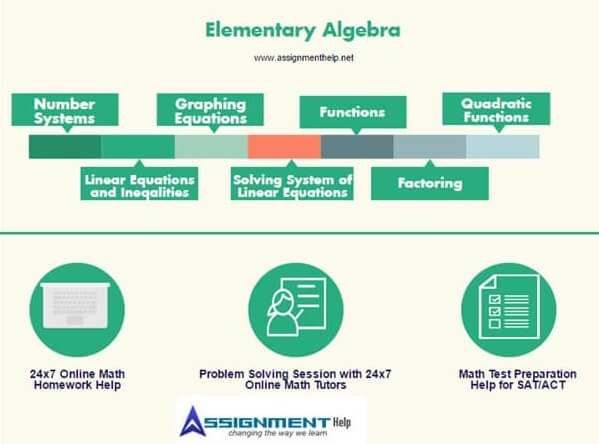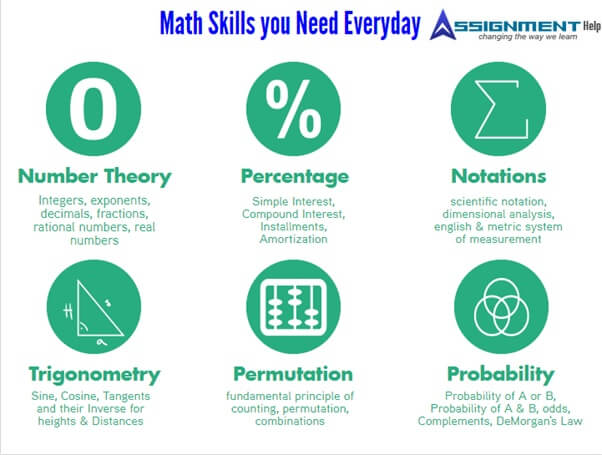Get Homework Help with Elementary Math Assignments
Elementary Algebra Homework help
The Assignment on elementary algebra is for students who have just started learning algebra and pre-algebra topics such as the arithmetic of numbers including integer number systems and mathematical operations on integers such as integer subtraction, integer multiplication and finding the absolute value of integers along with their mathematical properties. Students are also expected to learn about solving algebraic expressions as well as graphing them. Rational and Irrational number system is introduced with concepts of mathematical operations of fractions and decimals as well as graphing fractional forms and rounding off decimals. To represent decimal numbers, scientific notation forms are used as well as methods of multiplying decimal numbers by powers of ten.
Students are also expected to learn about the distributive property and how to apply it in algebraic expressions such as while distributing a negative sign and combining like terms. With rational number systems students are also taught about rational expressions later in the Assignment as well as how to simplify rational expressions through operations of adding, subtracting, multiplying and dividing rational expressions and finding least common denominator (LCD).
As the Assignment proceeds students learn about solving linear equations and inequalities in one variable through one-step and multiple steps processes such as wrap and unwrap, do and undo, operations that produce equivalent equations and simplifying expressions containing variables on both sides of the equation. At times students can face difficulty in solving linear equations when they involve fractions and decimals. In such cases, students need to learn the tricks of cancelling as well as clearing decimals and fractions from the linear equations through geometric formulae. Word Problems are assigned to students to explain applications of inequalities in different areas other than mathematics such as business math, sciences, statistics, physics, chemistry and computer science. In set theory Assignment of elementary algebra, students are taught about ordering of real numbers and creating sets in set-builder and interval notations as well as about equivalence in sets and dealing with set inequalities.
In elementary algebra and pre-algebra Assignment students must thoroughly learn about graphing equations. These equations can either be graphed through hand such as by plotting ordered pairs in a Cartesian plane or graphing equations of two variables by table of hit and trial method. Students can also use the graphing calculator’s TABLE function and produce calculator results in their homework assignments. While graphing equations students are taught about the concepts of slope and intercepts, interpreting slope as rate of change of a variable and the geometry of the slope of a line indicating its steepness. Students must be able to plot and distinguish between various forms of straight lines such as the slope-intercept form of a line, point-slope form, as well as the standard form of a line and being able to change from point slope form to the standard form or from a slope-intercept form producing the standard form.

When students learn about solving a system of linear equations it is generally by the methods of solving systems by graphing, solving systems by substitution or solving systems by elimination. For each of these methods of solving a system of linear equation, students should also learn about the applications of linear equation systems as well as the exceptional cases for all the three methods. Students also learn tricks to solve rational equations mathematically as well as through graphing calculators.
As the Assignment progresses, students are taught the concepts of functions in mathematics through definition of functions and the process of mapping functions diagrams. A special type of function known as polynomial function is taught in the beginning for finding zeros and x-intercepts of a functions. Students are also taught about conducting mathematical operations on monomials, binomials, polynomials as well as laws of exponents such as multiplying and dividing with like bases, as well as raising a power, product or a quotient to a power and raising to a negative integer and clearing negative exponents. Students also learn about concepts of direct and inverse variations and applications of inversely proportional formula.
As special products of polynomials students are expected to familiarise themselves with the FOIL method, differences of squares and squaring binomials.
Factoring is an important method of solving non-linear equations. For learning about factoring, students are first taught about finding the greatest common factor (GCF) as well as how to factor out the GCF and factoring by grouping method. In solving non-linear equations, students learn about using the ac-method of factoring ax2 + bx + c when a = 1. As exceptions factoring is then taught for solving ax2 + bx + c when a ≠ 1.
Factoring special forms involves the perfect square trinomials, the difference of squares as well as factoring strategies such as the ac-method and complete factoring. Applications of factoring is much useful in business and commercial mathematics as well as sciences of physics, chemistry etc.
In the end of the Assignment students are expected to master concepts of quadratic functions to solve and graph quadratic equations. Students learn about representations of radical notations as well as properties of radical notations and approximating square roots. Within this sections the Pythagorean theorem as well as proof of Pythagoras theorem is also included. Students are taught methods of completing the squares and solving quadratic equations through completion of squares as well as exercises and applications of perfect square trinomials. In the end students learn the quadratic formula of solving roots as well as determining if the equation has real and distinct roots.
Get Help with Basic Math Skills for the Modern World
The Assignment on basic math skills for the modern world includes real world applications of mathematics topics in areas such as finance, economics, business, biology, population growth as well as physical sciences such as physics and chemistry. The mathematics topics covered under this unit include problem solving, analysis and graphical interpretation based on algebra theory such as number systems, exponents, integers, fractions, decimals and polynomials, calculus, geometry, trigonometry, statistics and probability.
Students are expected to learn about number theory and numeration systems on base-ten system and other different bases, exponential and scientific forms, properties of exponents such as multiplication of like bases and raising powers to powers and raising powers to quotients and products. Students learn about number systems such as Natural Numbers, Whole Numbers, Prime Numbers and composite numbers, Integer system as well as rational numbers, fractions and real number system. Perhaps the most important mathematics concept that people use almost every day in their lives is that of percents. Applications of Percentages in real life involves computation of simple and compound interest, with different time frequencies such as quarterly, annually and semi-annually and knowing when to apply which format of rate of interest. Students also learn about financial analysis such as understanding how instalments work and calculating instalment loans of student loans, vehicle loans and home loan calculations as well as Amortization. Students of physical sciences routinely use mathematical concepts based on dimensional analysis, switching between English and metric system of measurements, representing numbers in scientific notations or converting from decimals to fractions and from fractions to decimals as well as expressing decimals in powers of ten.
Right triangle trigonometry is frequently used in calculations of areas, parameters and volumes of objects shaped as parabola, ellipse, cone, pyramids, sphere, hemisphere and others conic sections. This requires study of angles, similar and congruent triangles well as trigonometry. Students must develop an understanding of sine, cosine and tangent of angles of a right triangle and their inverse.
Assignment of arrangements and combinations as well as fundamental counting principle are taught with the help of permutations and combinations which further delves into statistical analysis based on calculation of probabilities, odds and risk ratios. Students must develop an understanding of calculating probability of A or B and distinguish it from probability of A or B as well as learn about the complementary probability and De Morgan Laws.

There are several mathematical concepts such as understanding the difference between factors and multiples as well as computing the greatest common factor (GCF) and least common multiple (LCM) that can help students to speed up their everyday calculations.
Students should also be taught to use the rules for divisibility as well as be able to do the prime factorization of a number, and how to use it to find the GCF and LCM of two numbers.


